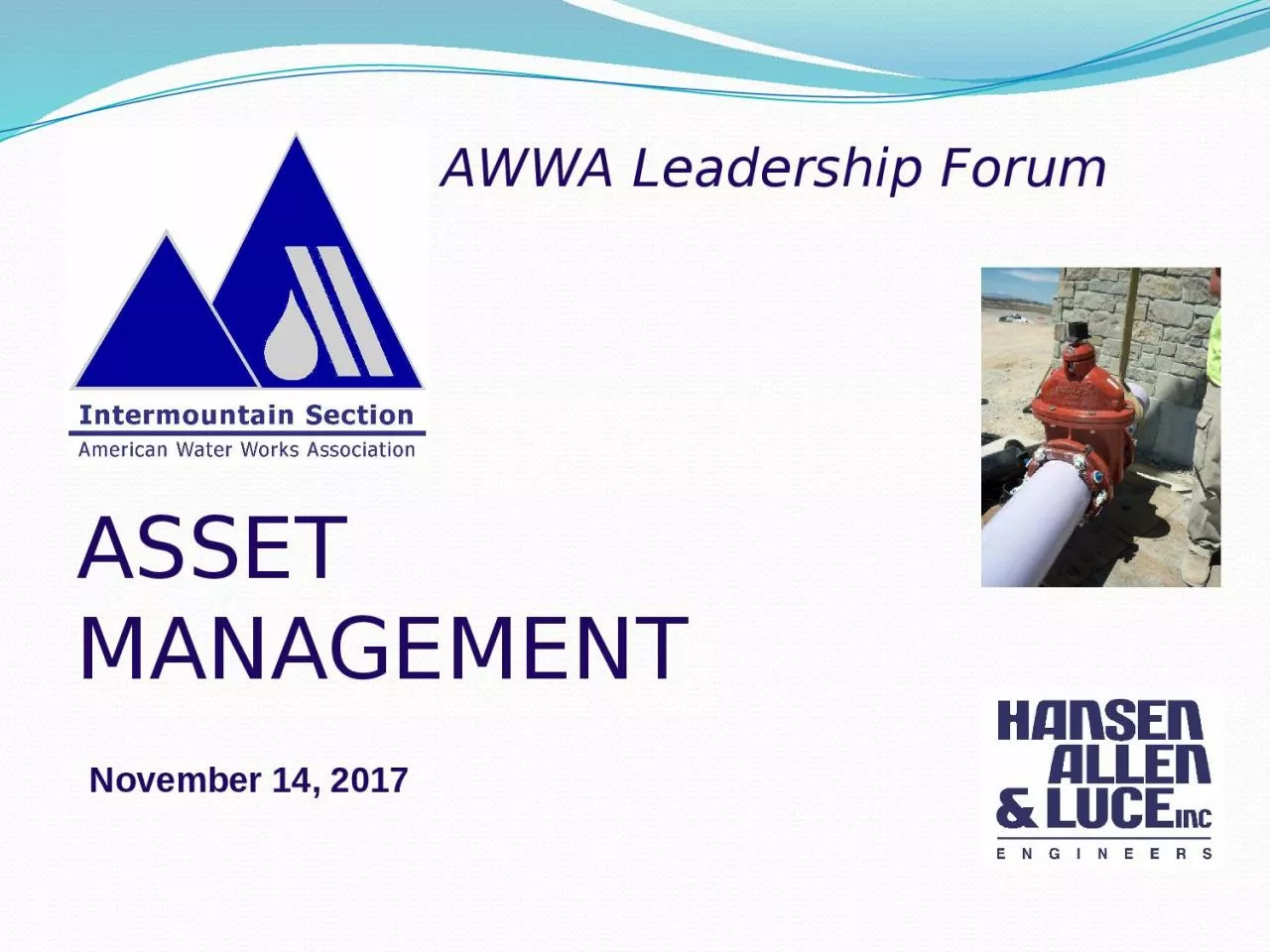

14 2017 ASSET MANAGEMENT Outline of Presentation What is Asset Management Structured Program Customer Service Expectations Planned Maintenance Setting Aside Reserves Minimizing Whole Life Costs ID: 1028666
Download Presentation The PPT/PDF document "AWWA Leadership Forum November" is the property of its rightful owner. Permission is granted to download and print the materials on this web site for personal, non-commercial use only, and to display it on your personal computer provided you do not modify the materials and that you retain all copyright notices contained in the materials. By downloading content from our website, you accept the terms of this agreement.
1. AWWA Leadership ForumNovember 14, 2017ASSET MANAGEMENT
2. Outline of PresentationWhat is Asset Management?Structured ProgramCustomer Service ExpectationsPlanned MaintenanceSetting Aside Reserves Minimizing Whole Life Costs2
3. What is Asset Management?
4. Asset Management Simplified4Initial PurchaseAutomobile LifespanExpenditures100,000 Mile Repairs150,000 Mile RepairsSale or Trade InPlanned Maintenance CostsSource: Adapted from www.efcnetwork.orgDependabilitySelected Performance Expectation
5. Element 1: A Structured Program
6. Each Part of the Organization Sees Part of the ElephantO&M sees: Trucks, crews, pumps, etc.Engineering sees: Studies, capital costsFinance sees: Interest, other financial costsIT sees: Cost of IT systems (SCADA, GIS, Network, Computers)Few see: Internal and external overhead6
7. Each Part of the Organization Has an Interest7
8. Each Part of the Organization Needs to Participate in the AM Program8
9. Element 2: Customer Service Expectations
10. Getting Started in a Structured WayTwo ComponentsWhere are we now, and Where do we want to be?“Gap Analysis” AM Plan Supports Closing the Gaps10
11. Gap AnalysisWhere are we now ?Source of Water Supply = 110 % of Peak Demand11Where do we want to be ?Source of Water Supply = 150 % of Peak Demand
12. Gap AnalysisHow to we increase Supply to 150 % of Peak Day Demand ?12
13. Element 3: Planned Maintenance
14. Planned Maintenance14Initial PurchaseAutomobile LifespanExpenditures100,000 Mile Repairs150,000 Mile RepairsSale or Trade InPlanned Maintenance CostsSource: Adapted from www.efcnetwork.orgDependabilitySelected Performance Expectation
15. Planned MaintenanceWhat Is Likely To Fail Eventually Without Maintenance?How Often Should That Asset Be Maintained to Prevent Failure?15
16. Examples: Why do we…Replace pipes? Reduce risk of water main breaks and outages Monitor pumping Reduce risk of water stations? outagesHave redundant pumps? Reduce risk of asset failure and water outagesDo preventive Same maintenance?Increase system capacity? Reduce risk of capacity- related delivery constraints16
17. 17Consequences ($)Likelihood of FailureL M HHMLFocus Your Efforts HereLikelihood of Failure……or Consequences of Failure
18. Risk Cost: A Rational Approach Risk cost is an inherent cost of asset ownershipIt is the product of the likelihood of an event and the dollar consequence of that eventOnce we know the risk cost, we can make rational decisions on reducing risk18
19. Example: Risk Cost of Having Your Car TowedAverage towing bill: $240Average frequency of needing a tow for your make/model of car: 8 yearsAnnualized risk cost: $240 x 1/8 = $30Add overhead and profit: $10Insurance company assumes your risk cost of towing: $40 per year19
20. Consequences of Failure Include Both Direct and Indirect CostsDirect repair costsLoss of production/revenueSocial costs (traffic, cleanup, health, etc.)Image repair costsLegal costsFines, penalties20
21. Element 4: Setting Aside Reserves
22. Setting Aside ReservesBond Reserve Fund Typically = 25% of Annual Bond PaymentHow Much Can Your Organization Afford to Set Aside For Repair and Replacement?Option = Annual Depreciation Amount22
23. Depreciation$ X = Original Cost of Asset Y = Life Expectancy, Years$X/Y = Annual Depreciation23
24. Example: Pump Station$ 500,000 = Original Cost of Asset 40 = Life Expectancy, YearsDepreciation = $500,000/40 = $12,500/year24
25. Element 5: Minimizing Whole-Life Costs of Asset Ownership
26. Asset Life Cycle CostExample: Deep Well Pump StationConsider Capital CostsConsider Annual Operating CostsConsider Annual Maintenance CostsConsider Annual Repair & Replacement Costs Add Costs and Prepare NPV Cost26
27. Asset Life Cycle CostExample: Deep Well Pump StationCapital Costs…………………………………..$213,743/yrAnnual Operating Costs………………….$80,000/yrAnnual Maintenance Costs……………..$25,000/yrAnnual Repair & Replacement………...$25,000/yr Net Present Worth Cost………………..$5,563,33127
28. What Service Levels Provide Lowest Overall Costs?28Unplanned R&RPlanned R&RTotal CostLowHighLevel of ServiceCost
29. AM Benefits Add Up. . .USEPA estimates that good AM will result in at least a 20 percent reduction in asset ownership costs29
30. SummaryAsset Management is:Structured ProgramCustomer Service ExpectationsPlanned MaintenanceSetting Aside Reserves Minimizing Whole Life Costs30
31. 31Questions?